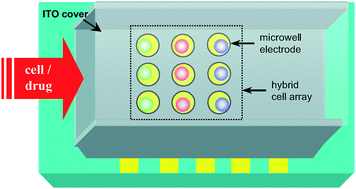Entrapment and measurement of a biologically functionalized microbead with a microwell electrode
Abstract
A chip with integrated electrophoretic and electrochemical systems was developed to manipulate either an individual microbead or a cell inside a microwell electrode (MWE) for electrochemical measurement. The optimal MWE geometry (30 µm diameter and 25 µm depth) was designed to accommodate the micro particles according to the simulated results. A chip device was sequentially built from a slide patterned with Pt electrodes, an adhesive tape defined with a flow channel (200 µm in width and 25 µm in height), and an indium tin oxide (ITO) cover. The MWE not only generated an active electrophoretic force to trap the particle but also provided a low flow velocity area (LFVA) to stabilize the trapped bead or cell in a continuous flow.


 Please wait while we load your content...
Please wait while we load your content...